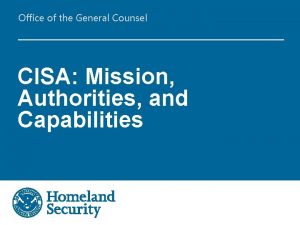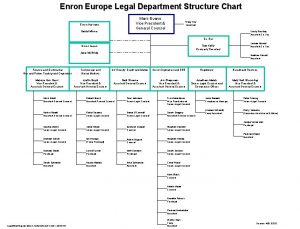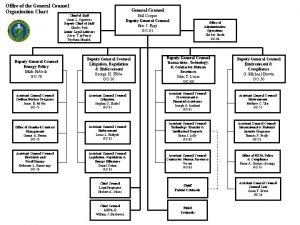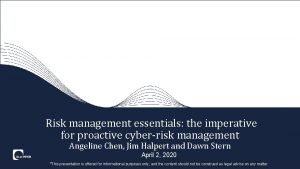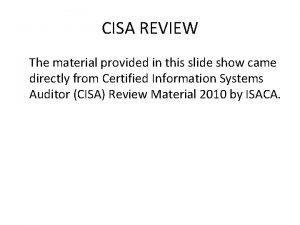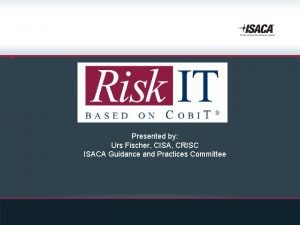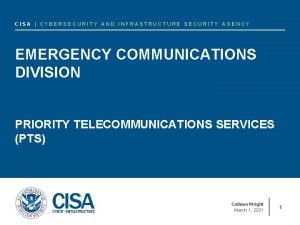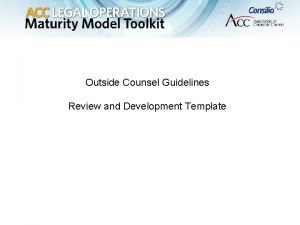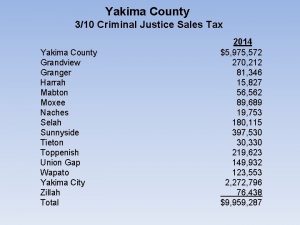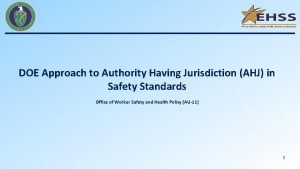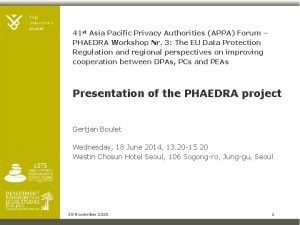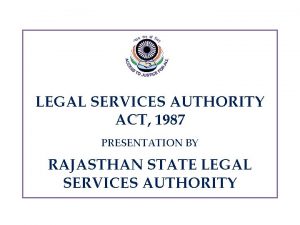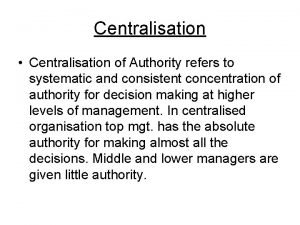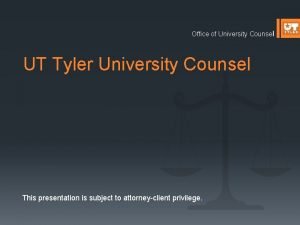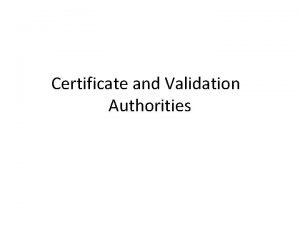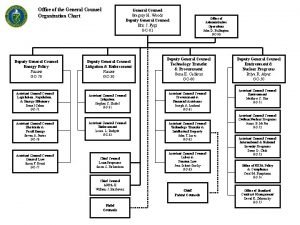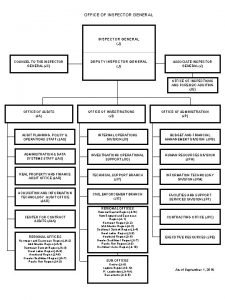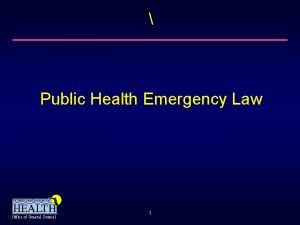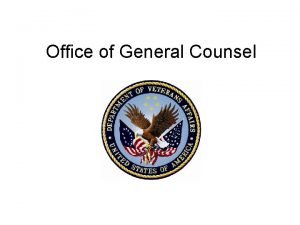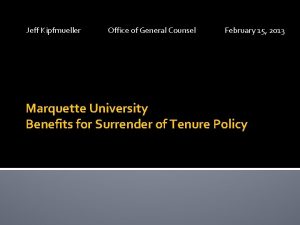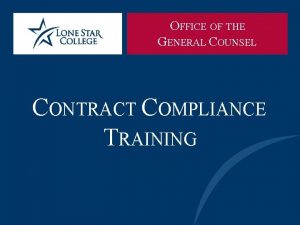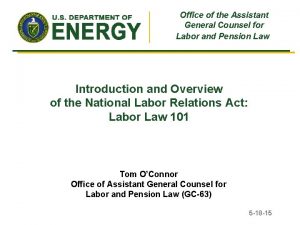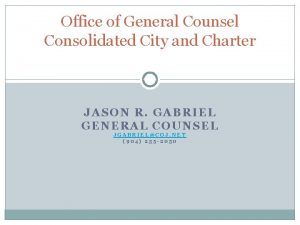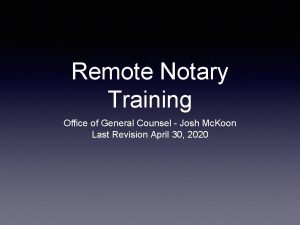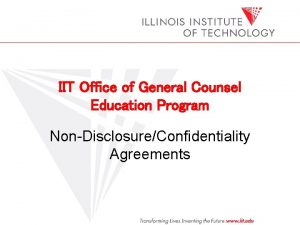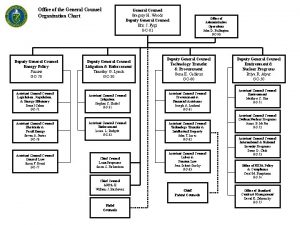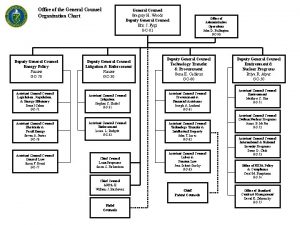Office of the General Counsel CISA Mission Authorities




























- Slides: 28

Office of the General Counsel CISA: Mission, Authorities, and Capabilities

Composition of our Client 6 USC § 652(f) Composition The Agency shall be composed of the following divisions: (1) The Cybersecurity Division, headed by an Assistant Director. [6 U. S. C. § 653] • The NCCIC is located in CISA and the head of the NCCIC reports to the Assistant Director for Cybersecurity. 6 USC § 659(b) (2) The Infrastructure Security Division, headed by an Assistant Director. [6 USC § 654] (3) The Emergency Communications Division under subchapter XIII, headed by an Assistant Director. [6 USC § 571] * National Risk Management Center (NRMC) 2

CISA Cybersecurity Responsibilities Information sharing and technical assistance involving federal and non-federal entities Protecting federal, civilian, executive-branch agencies Coordinating the federal government’s response to incidents 3

Cybersecurity Division’s Main Activities and Programs INFORMATI ON SHARING INSTRUMENTI NG DIRECTING ASSESSING RESPONDING AND RECOVERY UNCLASSIFIED // FOR OFFICIAL USE ONLY 4

CISA’s Cybersecurity Authorities Multiple sources of authority and direction, but here are some primary examples: The Homeland Security Act of 2002 Subtitle A of Title XXII 1 2 Section 2209 National cybersecurity and communications integration center (6 U. S. C. § 659) Section 2205 - Enhancement of Federal and Non-Federal Cybersecurity (6 U. S. C. § 655) 3 Section 2202 (6 U. S. C. § 652) 4 Section 2210 - Cybersecurity plans (6 U. S. C. § 660) 5 6 Section 2213 Federal intrusion detection and prevention system (6 U. S. C. § 663 & 663 note) Section 2208 Cybersecurity recruitment and retention (6 U. S. C. § 658)

CISA’s Cybersecurity Authorities Multiple sources of authority and direction, but here are some primary examples: The Cybersecurity Information Sharing Act of 2015 6 U. S. C. §§ 1501 -1510 Critical Infrastructure Information Act, Title II, Part B of Pub. L. No. 107296 6 U. S. C. § 673 Federal Acquisition Supply Chain Security Act of 2018, Title II of Pub. L. No. 115390 41 U. S. C. §§ 1321 -1328 Subchapter II of Chapter 35 of Title 44 (created by the Federal Information Security Modernization Act of 2014 (FISMA)) Presidential Policy Directive 41, United States Cyber Incident Coordination (July 27, 2016) Presidential Policy Directive 21, Critical Infrastructure Security and Resilience (2013)

CISA Cybersecurity Responsibilities Information sharing and technical assistance involving federal and non-federal entities Protecting federal, civilian, executive-branch agencies Coordinating the federal government’s response to incidents

Information Sharing and Technical Assistance Involving Federal and Non-Federal Entities What CISA does: CISA is authorized to share information related to cybersecurity risks and incidents, and provide technical assistance upon request With whom CISA interacts: At its sole and unreviewable discretion, CISA engages with all stakeholders – federal and nonfederal entities, including international partners – and coordinates information sharing. Mechanisms for action: To fulfill its cybersecurity functions, CISA enters into information sharing relationships and agreements, and operates the NCCIC.

Information Sharing and Technical Assistance Involving Federal and Non-Federal Entities The Homeland Security Act of 2002 Section 2209 6 U. S. C. § 659 The NCCIC has explicit authority to: RECEIVE information relating to cybersecurity risks and incidents. 6 U. S. C. § 659(c)(1) ANALYZE and INTEGRATE “including cross-sector integration and analysis, of cyber threat indicators, defensive measures, cybersecurity risks, and incidents. ” 6 U. S. C. § 659(c)(5)(A) DISSEMINATE “cyber threat indicators, defensive measures, and other information related to cybersecurity risks and incidents with Federal and non-Federal entities” and for providing guidance and recommendations Accepting this guidance is voluntary as no private entity is required “to implement any measure or recommendation suggested by the Secretary. ” Pub. L. No. 113 -282, § 8(b)(2), 128 Stat. 3066, 3072(2014) (codified at 6 U. S. C. § 659, note)

Information Sharing and Technical Assistance Involving Federal and Non-Federal Entities Cybersecurity Information Sharing Act of 2015 Non-federal entities can share cyber threat indicators (CTIs) and defensive measures (DMs) notwithstanding any other law. 6 U. S. C. § 1503(c). • Requires removal of certain personal information. 6 U. S. C. § 1503(d)(2). DHS develops a capability and process that accepts Cybersecurity Threat Indicators and Defensive Measures from any non- 6 U. S. C. §§ 1501 -10

INFORMATION SHARING Support national level enterprise risk management through information sharing • Automated Indicator Sharing (AIS) – Bi-directional, machine-speed sharing of threat indicators • Enhanced Cybersecurity Services (ECS) – Intrusion detection/prevention system with government information (classified and unclassified) to augment organization’s capabilities • Cyber Information Sharing and Collaboration Program (CISCP) – Public-private information sharing group CYBERSECURITY IS A TEAM SPORT UNCLASSIFIED // FOR OFFICIAL USE ONLY CONTACT: ncciccustomerservice@hq. dhs. gov 11

How We Protect Information shared through CISCP/AIS is sanitized to protect stakeholders’ identities. CSD will not disclose information that is exempt from disclosure under FOIA Sharing of that information is governed using the Traffic Light Protocol (TLP). Shared information is made available to the limited sharing community through the HSIN. https: //www. first. org/ tlp Stakeholders that share information with or receive technical assistance from the NCCIC may invoke Protected Critical Infrastructure Information (PCII) protections. https: //www. dhs. gov/ Stakeholders that share pcii-program information with the NCCIC are eligible for certain protections under CISA so long as the stakeholder meets certain requirements. See detailed guidance at https: //us-cert. gov/ais 12

Information Sharing and Technical Assistance Involving Federal and Non-Federal Entities The Homeland Security Act of 2002 Section 2209 6 U. S. C. § 659 The NCCIC is authorized to provide timely technical assistance, risk management support, and incident response capabilities to Federal and non-Federal entities with respect to cyber threat indicators, defensive measures, cybersecurity risks, and incidents, which may include attribution, mitigation, and remediation. ” 6 U. S. C. § 659(c)(6); Technical assistance includes: Connecting to entities’ networks Providing vulnerability assessments Scanning those networks Deploying technical capabilities during an incident

Help non-Federal entities assess their cybersecurity posture ASSESSING The Cyber Resilience Review (CRR) The External Dependencies Management (EDM) The Cyber Infrastructure Survey (CIS) The Phishing Campaign Assessment (PCA) Vulnerability scanning (formerly known as Cyber Hygiene scanning) The Validated Architecture Design Review (VADR) The Cyber Security Evaluation Tool (CSET) UNCLASSIFIED // FOR OFFICIAL USE ONLY CONTACT: ncciccustomerservice@hq. dhs. gov 14

Support intrusion analysis and mitigation RESPONSE AND RECOVERY Incident Response Teams provide intrusion analysis and mitigation guidance to requesting entities Hunt and Incident Response Teams (HIRT) Incident triage Network topology review Log analysis Incident specific risk overview Hunt analysis Malware analysis Mitigation Digital media analysis Control systems incident analysis UNCLASSIFIED // FOR OFFICIAL USE ONLY CONTACT: ncciccustomerservice@hq. dhs. gov 15

CISA Cybersecurity Responsibilities Information sharing and technical assistance involving federal and non-federal entities Protecting federal, civilian, executive-branch agencies Coordinating the federal government’s response to incidents

Protecting federal, civilian, executive-branch agencies Subchapter II of Chapter 35 of Title 44 (created by the Federal Information Security Modernization Act of 2014 (FISMA)) OMB oversees agency information security policy and practices. 44 U. S. C. § 3553(a). DHS/CISA administers the implementation of agency information security policies and practices in consultation with OMB. 44 U. S. C. § 3553(b). Commerce/NIST issues standards and guidance tied to FISMA. 44 U. S. C. §§ 3553 -54; see also 40 U. S. C. § 11331 a. Agencies provide information security protections commensurate with the risk to agency information and information systems and in compliance with OMB policy, DHS directives, and NIST standards. 44 U. S. C. § 3554. (In DHS, the CIO fills this role). 17

Protecting federal, civilian, executive-branch agencies The Department’s federal information security authorities apply to only federal civilian Executive Branch agencies, with important exclusions. CISA administers the implementation of governmentwide cybersecurity policies. CISA operates a federal information security incident center within the NCCIC and receives reports of cybersecurity incidents. 44 U. S. C. § 3553(b)(6)(A). CISA issues directives CISA deploys technology, including the Continuous Diagnostics and Mitigation (CDM) Program and EINSTEIN

INSTRUMENTI NG Detect and prevent cybersecurity threats from compromising Federal agency networks National Cybersecurity Protection System (NCPS) Detects characteristics of internet traffic to and from agencies E 1 Detects and alerts on known malicious traffic E 2 UNCLASSIFIED // FOR OFFICIAL USE ONLY Detects and blocks known malicious traffic using classified information E 3 A 19

INSTRUMENTI NG Detect and prevent cybersecurity threats from compromising Federal agency networks Continuous Diagnostics and Mitigation (CDM) UNCLASSIFIED // FOR OFFICIAL USE ONLY 20

BOD 15 -01, Critical Vulnerability Mitigation Requirements for Federal Civilian Executive Branch Departments and Agencies’ Internet-Accessible Systems (May 21, 2015) BOD 16 -01, Securing High Value Assets (June 9, 2016) Binding Operational Directives (BOD) and Emergency Directives (ED) BOD 16 -02, Threat to Network Infrastructure Devices (Sept. 27, 2016) BOD 16 -03, 2016 Agency Cybersecurity Reporting Requirements (Oct. 17, 2016) BOD 17 -01 Removal of Kaspersky-Branded Products (82 Fed. Reg. 43782, Sept. 19, 2017) BOD 18 -01 Enhance Email and Web Security (October 16, 2017) BOD 18 -02 Securing High Value Assets (May 7, 2018) FOR MORE INFORMATION: https: //cyber. dhs. gov/directives ED 19 -01: Mitigate DNS Infrastructure Tampering (January 22, 2019) 21

Protecting federal, civilian, executive-branch agencies Subchapter III of Chapter 13 of Title 41 (created by the Federal Acquisition Supply Chain Security Act of 2018) OMB leads the Federal Acquisition Security Council. 41 U. S. C. § 1322(c). DHS/CISA participates on the Council, issues exclusion and removal orders, and assists agencies with requirements to improve their management of supply chain risks. 41 U. S. C. §§ 1323(c); 1326(d). Federal Acquisition Security Council establishes criteria for information sharing and recommends government-wide exclusions and removals of products. 41 U. S. C. § 1323. OMB (chair), GSA, DHS, DNI, DOJ, Commerce. 41 U. S. C. § 1322(b). Agencies develop an overall supply chain management strategy and implementation plan and are authorized to mitigate or take procurement actions to address supply chain risks as part of FISMA responsibilities. 41 22

CISA Cybersecurity Responsibilities Information sharing and technical assistance involving federal and non-federal entities Protecting federal, civilian, executive-branch agencies Coordinating the federal government’s response to incidents

Coordinating the federal government’s response to incidents Actual Coordination. See 6 U. S. C. § 659; 44 U. S. C. § 3553; PPD-41. CISA has a coordinating role in the context of the “unity of effort within the Federal Government” and the “close coordination between the public and private sectors” in responding to cybersecurity incidents. Planning Documents and Exercises. Leveraging Support from Other Agencies. See 6 U. S. C. § 660; PPD -41. See EO 12333; PPD-41; DSCA As part of its coordination efforts, the Department is also charged with developing, maintaining, updating, and exercising cyber incident response plans—including “the National Cybersecurity Incident Response During a cybersecurity incident, the Department is authorized to leverage certain Presidential authorities, as well as request technical assistance from the Intelligence Community and support from the

Coordinating the federal government’s response to incidents PPD-41 FOR SIGNIFICANT INCIDENTS Lead Federal Agencies for the three lines of effort: The NCCIC for asset response FBI and NCIJTF for threat response Coordination Architecture Entities The Cyber Response Group (CRG) for National Policy Per-incident Cyber Unified Coordination Groups (UCGs) for National Operational Coordination ODNI for intelligence support 25

Coordinating the federal government’s response to incidents Planning Documents and Exercises National Cyber Incident Response Plan (NCIRP) Roles and Responsibilities in cyber incident response of the Federal Government, the private sector, and SLTT governments and how the government will organize its activities to manage the effects of significant cyber incidents. Lessons Learned from exercises, real world incidents, and policy and statutory updates, such as the PPD-41 and amendments to the Homeland Security Act.


Information Sharing and Technical Assistance Involving Federal and Non-Federal Entities In addition to being authorized by statute, the Department’s actions must be: Consistent with the Fourth Amendment to the U. S. Constitution. Comply with criminal prohibitions, and The Wiretap Act, Pen/Trap Act, Stored Communications Act, and Computer Fraud and Abuse Act. Use available funding under relevant Congressional appropriations. Requests for Technical Assistance – private sector CONSENT Federal Network Authorization – civilian government agency In some cases, the NCCIC must seek and obtain the consent of the entity’s network users, prior to connecting to an entity’s network, deploying technical capabilities on an entity’s network, or capturing network traffic. (i. e. banners) 28
 Cisa crr
Cisa crr Iit general counsel
Iit general counsel Legal department structure
Legal department structure Organigram general counsel
Organigram general counsel Www.gucci.com usa
Www.gucci.com usa Apostles lds seniority
Apostles lds seniority Cisa evolution
Cisa evolution Sae
Sae Angeline chen dla piper
Angeline chen dla piper Cisa domains
Cisa domains Cisa audit methodology
Cisa audit methodology Cisa crisc
Cisa crisc Hrsrh
Hrsrh Cisa ecd
Cisa ecd A wise man seeks counsel
A wise man seeks counsel Preach the whole counsel of god
Preach the whole counsel of god Outside counsel guidelines template
Outside counsel guidelines template Novo nordisk legal counsel
Novo nordisk legal counsel Yakima county department of assigned counsel
Yakima county department of assigned counsel Marcus evans enterprise in-house counsel
Marcus evans enterprise in-house counsel 1997 code of ethics for professional teachers
1997 code of ethics for professional teachers Ahj authority having jurisdiction
Ahj authority having jurisdiction Fthun
Fthun Asia pacific privacy authorities
Asia pacific privacy authorities Rajasthan legal services authority
Rajasthan legal services authority Example of traditional authority in the philippines
Example of traditional authority in the philippines Authority refers to
Authority refers to Rieslin hub
Rieslin hub Mrs bowles character traits
Mrs bowles character traits
